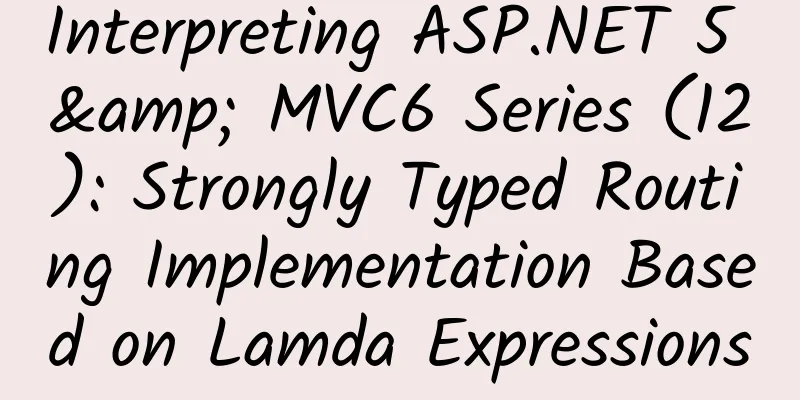Interpreting ASP.NET 5 & MVC6 Series (12): Strongly Typed Routing Implementation Based on Lamda Expressions

|
In the previous chapter, Understanding Routing, we talked about how, in MVC, in addition to using the default ASP.NET 5 routing registration method, you can also use Attribute-based features (Route and HttpXXX series methods) to define. In this chapter, we will talk about a strongly typed type based on Lambda expressions. The following is a basic example of how to use this approach:
As can be seen from the example, we can define the route through extension methods such as GetRoute or PostRoute, and then use Lambda expressions to define the type of Controller and the method of Action. Note that obtaining the method name of the Action here is achieved by delegating the execution of the Action method (it is not actually executed, but the MethodInfo of the Action is obtained based on this). Implementation principle When configuring services in the ConfigureServices method of Stratup.cs, we can configure the core configuration file MvcOptions used by the MVC site, where this class has an ApplicationModelConventions property (List
The parameter type received by the Apply method in the interface is ApplicationModel, and ApplicationModel has two extremely important contents for us to operate, one is the Controller model collection, and the other is the collection of various Filters. The definition of this class is as follows:
The most important thing here is the ControllerModel class. The instance of this class stores a variety of important and operational information, such as the route definition data on this class and related Actions, API description information, route constraints, etc. All this information can be operated. The new IApplicationModelConvention registration method is as follows:
Therefore, we can use this method to make responsive adjustments and modifications to the entire MVC program model at the appropriate time. The strongly typed routing in this chapter is implemented using this feature. Implementation steps First, define a strongly typed routing model TypedRouteModel class, which inherits from AttributeRouteModel. The AttributeRouteModel class is a basic model based on Attribute routing. The code of the TypedRouteModel class is as follows:
The main functions of this class are: defining supported incoming Controller types and supporting chain calls. Then define a TypedRoutingApplicationModelConvention class that inherits the IApplicationModelConvention interface. The code is as follows:
In this class, a static variable Routes is saved to save all routes declared in Lamda expression mode, and then search and modify them in the existing Controllers collection, replace the AttributeRouteModel property, and set the corresponding Http Method (if not set, all methods are allowed by default). Here, we simply replace action.AttributeRouteModel, which may lead to some defects (for example, an Action can only support one routing path, the last one shall prevail). You can optimize it according to your own ability. When optimizing, please note that the Route collection on the Controller is saved in the controller.Attributes property, and the Route collection on the Action is saved in the action.Attributes property, which can be optimized. Then, on MvcOptions, we add some extension methods to TypeRouteModel for easy use. The code is as follows:
In the above code, we added an EnableTypedRouting extension method to add a new TypedRoutingApplicationModelConvention type instance to the MvcOptions.ApplicationModelConventions property. Other extension methods are used to declare related routes. Please note that in the first example, we see that the method to obtain action information is to call the action method through delegation (but not actually call it), but some methods have parameters, what should we do? For this reason, we define a Param class that ignores parameters. The code is as follows:
In this way, when we define the route for the About method containing parameters, we can define it like this. The code is as follows:
opt.GetRoute("aboutpage/{name}", c => c.ActionIn addition, since many methods in TypeRouteModel can be chained, we can also specify a name for the route in this way. The sample code is as follows:
opt.GetRoute("homepage", c => c.Action(x => x.Index())).WithName("foo");At this point, the entire strongly typed routing function has been implemented, and everyone has one more choice when using it. Disadvantages (or Bugs) We can see that when implementing the IApplicationModelConvention interface above, we simply replace action.AttributeRouteModel. That is, if you have already set the Route attribute on the Action, it will overwrite your information, causing your route to fail. For example, if you define a custom route like this:
Then, a strongly typed route is defined through Lamda expression. The code is as follows:
Then, you can only access it through /homepage, but not through /index, because it overwrites your Route. However, the above Lamda expression method does not override the Route attribute definition defined on the Controller, so if you define the Route attribute on ProductsController, the two will be combined together, for example:
Then your access URL should be /products/homepage, not /homepage. However, if your code in Lamda expression mode is as follows:
Then your access URL should be /homepage, because the routing string is the absolute path /homepage, not homepage. Reference: http://www.strathweb.com/2015/03/strongly-typed-routing-asp-net-mvc-6-iapplicationmodelconvention/ |
<<: Interpreting ASP.NET 5 & MVC6 Series (11): Routing
>>: Interpreting ASP.NET 5 & MVC6 Series (14): View Component
Recommend
Teacher Yoyo's full English course
Introduction to Teacher Yoyo’s complete English c...
Why did Steve Jobs forbid his children from using iPads at home?
Although Apple invented the iPad, as one of the im...
Guangzhou WeChat Mini Program Mall Ranking, What are the factors that affect the ranking of mini programs?
Open the APP on your phone, no matter which e-com...
Example sharing: Innovative growth strategies of 12 top teams including Facebook, Airbnb, etc.
The original article lists 21 innovative growth e...
Gaining user trust is not that difficult
Aristotle created the persuasion triangle 2,000 y...
Google Chrome for Android gets two-factor authentication
[[415122]] In order to reduce the risk of Interne...
Influenza A has entered its peak period. What are the differences between its symptoms and those of COVID-19?
Recently, influenza A has entered its peak period...
National Day advertising strategies and methods for the education industry!
With the National Day holiday approaching, variou...
China's iOS app download list in October: TikTok ranked tenth with a 50% growth rate, while Honor of Kings remained in first place
In the iOS app download market in October, althou...
Two major directions of SEM search term promotion and optimization, revealing the mystery behind it!
Search terms are different from keywords. Keyword...
PC batch unfollow WeChat public account tool_Green Software Station, download software
During the Spring Festival, everyone must have fo...
Analysis of Xiaohongshu's brand marketing promotion mechanism
In the new consumption era, when brands are faced...
From 6 to more than 240, there is good news for the protection of South China tigers
Many cultures have such a creation myth: after a ...
Honda joins Baidu's Apollo platform to make self-driving cars a reality
Recently, according to a report by the Nikkei, Ho...
Nobel Prize winner warns: The fate of birds is our fate
With the sales of this little book, I would like ...









